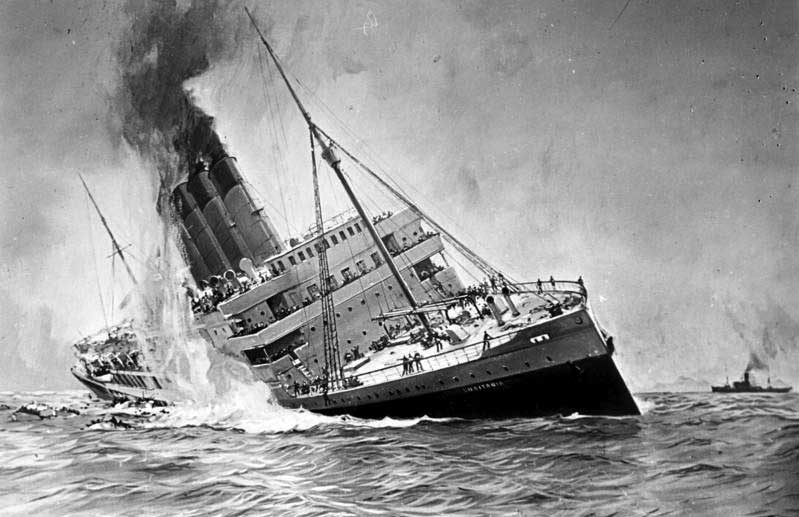Sinking of the Lusitania

Lusitania Sinking
128 American citizens were among the 1,200 passengers of the ocean liner Lusitania which was sunk by a German submarine. The sinking of the Lusitania poisoned relations between the United States and Germany, but did not immediately result in American intervention in the war.
Upon the outbreak of World War I, the United States declared its neutrality, a stance widely supported by the American populace, who harbored no desire to become entangled in the conflict. Notably, Great Britain, the United States’ largest trading partner, held significant influence over the nation’s foreign policy, and the US maintained its intention to continue trading with it, including supplying arms.
Despite the declaration of neutrality, the transatlantic voyages of Americans and Britons continued unabated. The British Cunard Line persisted in sailing its magnificent liners between Liverpool and New York. Notably, the RMS Lusitania, commissioned in 1907, stood as the fastest liner in service, capable of reaching speeds of 25 knots. While the German Navy had commenced employing submarines against British shipping, the Lusitania maintained its confidence in its superior speed, asserting its ability to evade any German submarine.
In late April, the German Embassy issued the following notice:
NOTICE
TRAVELLERS intending to embark on the Atlantic voyage are advised that a state of war exists between Germany and its allies, as well as Great Britain and its allies. The zone of war encompasses the waters adjacent to the British Isles. In accordance with formal notice issued by the Imperial German Government, vessels flying the flag of Great Britain or any of her allies are subject to destruction within these waters. Consequently, travelers embarking on the war zone aboard vessels of Great Britain or her allies assume the inherent risk of such destruction.
IMPERIAL GERMAN EMBASSY
Washington, D.C.
April 22, 1915
On May 1st, the Lusitania departed New York’s Pier 54 with 1,265 passengers and a crew of 694. In addition to the passengers, the ship carried munitions for Great Britain in its freight holds. As the ship approached the British Isles, the Royal Navy became concerned about its safety and dispatched destroyers to escort it. However, the Lusitania refused to communicate with the Royal Navy, and the escortships never intersected with the ship.
On April 30th, the German submarine U-20 departed from Borkum and set course for the Irish Sea. U-20 attacked several merchant ships, sinking three of them. The British Admiralty was aware of U-20’s presence off the coast of Ireland and issued a warning to all ships. The captain of the Lusitania, William Turner, took what he believed were prudent measures, securing watertight doors and preparing the lifeboats for potential evacuation.
By May 7th, Captain Walther Schwieger of U-20 decided to return home due to a shortage of torpedoes. At 12:45, while the submarine was surfaced, lookouts spotted a ship on the horizon. It turned out to be the large merchant vessel, the Lusitania. Schwieger ordered the submarine to approach the target. When the Lusitania was 700 meters away, U-20 fired a torpedo. The torpedo struck below the bridge, causing a significant secondary explosion. The captain ordered the ship to head for the Irish coast, but the engines were unable to respond. He soon ordered the crew to abandon ship, while the wireless operator sent out an SOS. The Lusitania sank 18 minutes after being struck by the torpedo. Of the 1,959 people aboard when the torpedo struck, 1,195 were lost.
The sinking of the Lusitania was a highly controversial event. Firstly, according to International Maritime Law at the time, a naval vessel that stopped a civilian vessel was required to allow the civilians to disembark before sinking the ship. However, this law was written before the advent of submarines, vessels that could easily be rammed by another ship if given a warning. The fact that 128 Americans were aboard the ship transformed the sinking into a crisis between Germany and the United States. Although it would be two years before the United States entered the war, the sinking gradually turned American public opinion against Germany.
 >
>